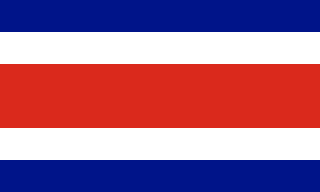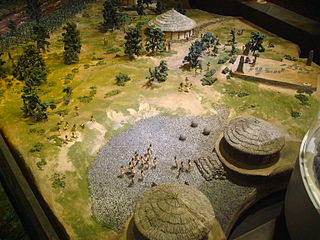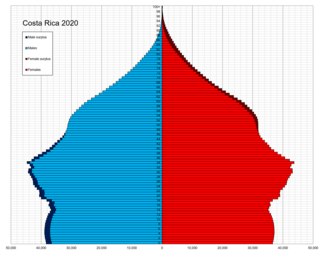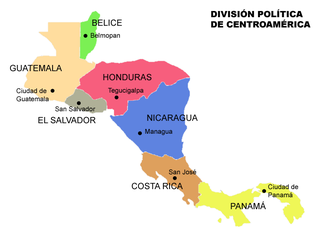Related Research Articles

Costa Rica, officially the Republic of Costa Rica, is a country in the Central American region of North America. It borders Nicaragua to the north, the Caribbean Sea to the northeast, Panama to the southeast, and the Pacific Ocean to the southwest, as well as maritime border with Ecuador to the south of Cocos Island. It has a population of around five million in a land area of nearly 51,180 km2 (19,760 sq mi). An estimated 352,381 people live in the capital and largest city, San José, with around two million people in the surrounding metropolitan area.

The first indigenous peoples of Costa Rica were hunters and gatherers, and when the Spanish conquerors arrived, Costa Rica was divided in two distinct cultural areas due to its geographical location in the Intermediate Area, between Mesoamerican and the Andean cultures, with influences of both cultures.

This is a demographic article about Costa Rica's population, including population density, ethnicity, education level, health of the populace, economic status, religious affiliations, and other aspects of the population.

San José is the capital and largest city of Costa Rica, and the capital of San José Province. It is in the center of the country, in the mid-west of the Central Valley, within San José Canton. San José is Costa Rica's seat of national government, focal point of political and economic activity, and major transportation hub. San José is simultaneously one of Costa Rica's cantons, with its municipal land area covering 44.62 square kilometers and having within it an estimated population of 352,381 people in 2022. Together with several other cantons of the central valley, including Alajuela, Heredia and Cartago, it forms the country's Greater Metropolitan Area, with an estimated population of over 2 million in 2017. The city is named in honor of Joseph of Nazareth.

José María Hipólito Figueres Ferrer served three terms as President of Costa Rica: 1948–1949, 1953–1958 and 1970–1974. During his first term in office he abolished the country's army, nationalized its banking sector, granted women and Afro-Costa Ricans the right to vote, and offered Costa Rican nationality to people of African descent.

The national flag of Costa Rica is based on a design created in 1848 and consists of two blue stripes, two white stripes, and a central red stripe which is twice as wide as each of the other four. The civil flag omits the coat of arms seen on the state flag, since the state variant is only permitted to be used by the government.

The Costa Rican Football Federation, also known as FEDEFUTBOL or FEDEFUT, is the official association football governing body in Costa Rica and is in charge of the Costa Rica national football team and the Costa Rica women's national football team.

Education in Costa Rica is divided in 3 cycles: pre-education, primary education, and secondary school, which leads to higher education. School year starts between the second and third week of February, stops at the last week of June, it continues again between the third and fourth week of July and finishes between the last week of November and the second week of December. Preschool and basic education are free to the public. Elementary and secondary school are both divided in two cycles. Since 1869, education is free and compulsory.

Celso Borges Mora is a Costa Rican professional footballer who plays as a central midfielder for Liga FPD club Alajuelense. With 163 international appearances, he is the most capped player in Costa Rica's history.

Central America is a subregion of the Americas formed by six Latin American countries and one (officially) Anglo-American country, Belize. As an isthmus it connects South America with the remainder of mainland North America, and comprises the following countries : Belize, Guatemala, Honduras, El Salvador, Nicaragua, Costa Rica, and Panama.

Instituto Costarricense de Electricidad (ICE) is the Costa Rican government-run electricity and telecommunications services provider. Together with the Radiographic Costarricense SA (RACSA) and Compañía Nacional de Fuerza y Luz (CNFL), they form the ICE Group.
The Costa Rican Tourism Board is the government agency responsible for promoting sustainable tourism in Costa Rica. Originally the agency was created by decree in 1931 as the National Tourism Board, and by a law approved on 9 August 1955, the agency became the Instituto Costarricense de Turismo (ICT).

Costa Ricans are the citizens of Costa Rica, a multiethnic, Spanish-speaking nation in Central America. Costa Ricans are predominantly Mestizos, other ethnic groups people of Indigenous, European, African, and Asian descent.

The Academia Nacional de Ciencias is Costa Rica's Academy of Sciences. It was created as a “permanent forum for discussion and scientific analysis,” and serves both as an honorific society and a source of scientific advice for the government. Its mandate is to promote scientific culture and progress within Costa Rica, and collaboration between national and international agencies. It maintains membership in international organizations such as the International Council for Science (ICSU), the InterAmerican Network of Academies of Sciences (IANAS) and the Third World Network (TWN). Its headquarters are in San Pedro in the province of San José.
Irazú was the first Costa Rican satellite to be launched into space. The nanosatellite was launched into space on 2 April 2018, on board a Falcon 9 rocket headed for the International Space Station. It was expected to orbit the Earth for six months with the function of monitoring carbon, humidity, and temperature levels in Costa Rican forests. Funds for the launch of satellite were provided, in a significant part, through a Kickstarter crowdfunding campaign.

The cinema of Costa Rica comprises the art of film and creative movies made within the nation of Costa Rica or by Costa Rican filmmakers abroad.
The COVID-19 pandemic in Costa Rica was a part of the ongoing worldwide pandemic of coronavirus disease 2019 caused by severe acute respiratory syndrome coronavirus 2. The virus was confirmed to have spread to Costa Rica on 6 March 2020, after a 49-year-old woman tourist from New York, United States, tested positive for the virus.
The Church of Jesus Christ of Latter-day Saints in Costa Rica refers to the Church of Jesus Christ of Latter-day Saints and its members in Costa Rica. The first branch was organized in 1950. As of December 31, 2022, there were 53,234 members in 78 congregations in Costa Rica.
Brisa Tomi Hennessy Kobara is a Costa Rican professional surfer who competes in the World Surf League (WSL). In 2019, Hennessy's standing in the WSL qualified her to represent Costa Rica for Surfing at the 2020 Summer Olympics in Tokyo, Japan. The Tokyo Olympics marked the first instance for surfing to be recognised as an Olympic sport. She participated at the 2024 Olympic Games achieving the fourth place, one of the best performances for a Costa Rican athlete.
Latin American and Caribbean Space Agency is an international space exploration organization based in Mexico, comprising several countries in Latin America and the Caribbean region. It was established in 2021 as part of the Latin American space race. According to its charter, its objective is to coordinate the space cooperation activities of Latin American and Caribbean countries for the peaceful use and exploration of outer space, the Moon and other celestial bodies.
References
- ↑ "List of World Space Agencies". Jagran Josh . 2021-12-30. Retrieved 2022-10-29.
- ↑ Colantuoni, Steve (2021-06-03). "The Costa Rican Space Agency has been created by the legislature". The Central American Group. Retrieved 2022-10-29.
- ↑ Callow, Bruce (2022-10-11). "Costa Rica's Space Agency Awaits Green Light". The Tico Times. Retrieved 2022-10-29.